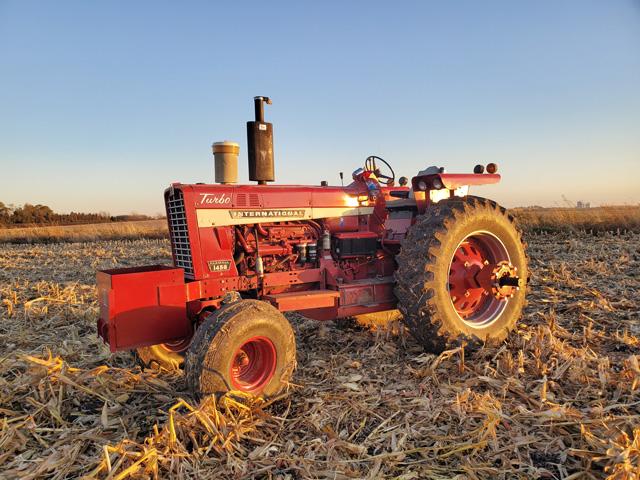Russ' Vintage Iron
100 Years of Farmall
OMAHA (DTN) -- I have written about this in the past but the only tractor my grandpa ever bought new was a mid-1940s International Farmall M he purchased at the end of World War II. With rationing still occurring and farm equipment availability limited, he managed to find one to buy.
The family story is his brother, who operated a sandpit in the area, was able to purchase an industrial M (painted yellow) and then resold it to his brother. My grandpa went to railyards of downtown Omaha, drove it home to their farm and the first thing he did was paint it Farmall red.
The other day I got an online press release from Case IH celebrating 100 years of Farmall. The release detailed some of the events the company is planning, including giving away a new Farmall series tractor, as well as a website all about 100 years of Farmall. (https://info.caseih.com/….)
The site has a timeline showing the history of the Farmall tractor. In 1923, an International Harvester (IH) engineer by the name of Bert R. Benjamin has a vision for a tractor which would replace horses and could do all the various chores on a farm, thus the name Farmall.
The very first truly mass-produced tractor at this time was the Fordson tractor, which had nearly the entire market share of the very young tractor market at the time. The one thing the Fordson tractor could not accomplish well was cultivating crops.
IH officials recognized this as an unmet need of the tractor market and set out to fill it (https://en.wikipedia.org/…). By 1923, they had settled on a design and "Farmall" was chosen as the product's official name.
According to the website, the management of IH was concerned about the new tricycle design and it might cause some customers to turn their noses up at the appearance, so the Farmall was only released in Texas. They did this to avoid potential embarrassment if the tractor was unsuccessful.
P[L1] D[0x0] M[300x250] OOP[F] ADUNIT[] T[]
The tractor did its many jobs well and become extremely popular with farmers in the mid-1920s. So much so that IH scaled up production and opened its new Farmall Works plant in 1926 in Rock Island, Illinois.
The first Farmalls were later known as the Regular. Again, according to the website, the name Regular was never an official name for branding, but it was a common term used by farmers.
In the early 1930s variations came from the original Farmall. The F-30 was introduced as a heavier, more powerful version of the original Farmall in 1931. IH then in 1932 began an entire line of Farmalls, which became known as the F-series with the F-20 and F-12. An F-14 was released later in the decade.
The red color didn't come along until mid-1936. All Farmall tractors were painted a deep blue gray with the wheels often being red. IH made the decision to change the entire tractor to a new color, the now famous Farmall Red.
Tractor manufacturers were moving to bright, distinctive colors at this time for branding purposes so a farmer could look across a field and know exactly what kind of tractor was working. Allis-Chalmers went to its familiar orange color about this time as well.
Then the Letter series was introduced in 1939 and Super series in early 1950s. The Farmall name continued into the Hundred series, the 60 series and various more number series in the 1960s and into the early 1970s.
By 1973, IH officially dropped the Farmall name from their new tractor models. The now-legendary name appeared on IH tractors for nearly 50 years.
But that was not the end of the Farmall.
The Farmall name was reintroduced by Case IH in 2004 on a new series of smaller tractors. This line featured utility tractors that had less than 55 horsepower.
In case you were wondering, the rest of the story of my grandpa's Farmall M tractor is he used it for over 20 years on his farm, tending to his dairy cows and growing crops. My uncle and dad took over the farm for him in 1968 and they traded the M in for used John Deere 730 diesel, their first diesel tractor.
Another local farmer purchased the Farmall M and when he had a farm equipment auction, his son-in-law bought the tractor. A grandson took the tractor to high school shop class and they repainted it when he was in high school in the late 1970s. The M was sold in a farm equipment auction near Kennard, Nebraska, after getting a new coat of paint.
And that is as far as I could trace it, no one knew who bought it at the sale. I have always thought it would be interesting to have that tractor, the first one he ever bought new; but it remains an unfilled dream.
What is your Farmall story? Do you have a multi-generational tractor in your family? Please let me know your story and we will run it in a future column.
Russ Quinn can be reached at russ.quinn@dtn.com
Follow him on Twitter @RussQuinnDTN
(c) Copyright 2023 DTN, LLC. All rights reserved.




